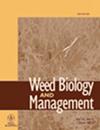Maize–soybean intercropping effect on yield productivity, weed control and diversity in northern Ghana
IF 1.5
4区 农林科学
Q3 AGRONOMY
引用次数: 9
Abstract
The cereal–legume cropping system is a common practice across the tropical world. However, there are limited quantitative data on the effect of cereal–legume intercropping on weed species diversity. A study was conducted in the Guinea savanna zone of Ghana to evaluate the effect of maize–soybean intercropping on yield productivity and weed species control. The treatments used include three maize maturity types (extra‐early: Abontem, early: Sammaz 27 and medium: Obatanpa) intercropped with soybean at three intraspacing (10, 20 and 30 cm), and their sole crop treatments were laid in a randomized complete block design with three replications. Results showed that the land equivalent ratio (LER) for the intercrops was above 1, indicating better intercrop productivity than the sole crops. An average of 40% land was saved for the intercrops compared with the sole crops. Intercropping Sammaz 27 maize with soybean significantly increased LER by 9% compared to the other types. Intercropping maize with soybean significantly reduced weed biomass at 6 and 9 weeks after planting (WAP) and at harvest relative to the sole maize. The weed biomass at 6 and 9 WAP and harvest increased (p < .05) with increasing soybean intraspacing. The grass and broadleaf weed species count at 6 WAP and harvest from the sole crops were significantly higher than that of the intercrops. The results suggest that intercropping early maize maturity type with soybean at 10 cm intraspacing could be used to increase grain yield, LER and control of grass and broadleaf weeds in a maize‐based cropping system in the Guinea savanna zones of West Africa.加纳北部玉米-大豆间作对产量、杂草控制和多样性的影响
谷类-豆类种植制度是热带世界的一种常见做法。然而,关于谷类-豆类间作对杂草物种多样性影响的定量数据有限。在加纳几内亚稀树草原地区进行了一项研究,以评估玉米-大豆间作对产量和杂草种类控制的影响。所用的处理包括三种玉米成熟类型(超早:Abontem,早:Sammaz 27和中等:Obatanpa)与大豆在三个间隔内(10、20和30)间作 cm),并且它们的唯一作物处理以具有三个重复的随机完全块设计铺设。结果表明,间作的土地当量比(LER)在1以上,表明间作生产力高于单一作物。与单一作物相比,平均为间作作物节省了40%的土地。大豆与Sammaz 27玉米间作使LER比其他类型显著提高9%。玉米和大豆间作显著降低了6和9日的杂草生物量 种植后数周(WAP)和收获时相对于唯一的玉米。6和9WAP时杂草生物量和收获量增加(p < .05)随着大豆种内起搏的增加。在6 WAP条件下,草和阔叶杂草的种类数和单一作物的收获量显著高于间作。研究结果表明,在西非几内亚稀树草原地区以玉米为基础的种植系统中,早熟型玉米与大豆在10 cm间隔内间作可用于提高粮食产量、LER以及控制草和阔叶杂草。
本文章由计算机程序翻译,如有差异,请以英文原文为准。
求助全文
约1分钟内获得全文
求助全文
来源期刊

Weed Biology and Management
农林科学-农艺学
CiteScore
2.70
自引率
0.00%
发文量
13
审稿时长
>36 weeks
期刊介绍:
Weed Biology and Management is an international journal, published four times per year. The journal accepts contributions in the form of original research and review articles in all aspects of weed science. Contributions from weed scientists in the Asia–Pacific region are particularly welcomed.
The content of the contributions may relate to weed taxonomy, ecology and physiology, weed management and control methodologies, herbicide behaviors in plants, soils and environment, utilization of weeds and other aspects of weed science. All contributions must be of sufficient quality to extend our knowledge in weed science.
 求助内容:
求助内容: 应助结果提醒方式:
应助结果提醒方式:


